QuestionQUESTION: I have a turtle that is sluggish, puffy eyes, swimming sideways, and shedding skin faster than he ought. Sounds like a respiratory infection to me. The nearest vet that handles reptiles is 200 miles away from me (I live in Northern Maine). There's a local vet that is friendly and helpful, but he doesn't know...he gave my turtle a total of 3 vitamin A injections on 3 seperate weeks, thinking that was the problem, and now I'm reading here that that can hurt my turtle! Is this a serious problem? The turtle doesn't seem any better or worse for it so far...should I reduce the Vitamin A in his diet? The vet also reccomended Cod liver oil drops, and now I'm afraid about that too after reading here that the vitamin a injection thing was 'old science' and 'harmful'. Anyways, I now have some oral Baytril I got from him, 22.7 mg tastetabs. Instructions are to give 1/4th of a pill once a day, for a 1 lb. red eared slider. I just got these today, so I can't tell you if it's helping, but now I'm scared about the vitamin A thing!
ANSWER: The symptoms you described could be several things other than a respiratory infection. It could be that your turtle already had hypervitaminosis, and this was made worse by vitamin A injection. It could also be a combination of things, which is why I REQUIRE proper background information be provided on your husbandry when asking medical related questions!!! There are some UV lights going around out there which are doing UV radiation damage to eyes, and close to the UVC range, which could be doing other tissue damage as well. But, I don't know if you have even a UVB source, because you didn't follow my directions and include this information as required. I should reject your question. You do want your turtle to be helped right?? Then you need to follow up with the information requested in my instructions. That's how I answer these questions. I assume you saw the instructions when you were typing the question. So, I assume you just felt that what I was asking for was not important enough for you to spend your time providing. I would like to ask you whether you walked into your vet and just set the turtle down, and asked the vet to do something with it, without providing any other information to him???
In the interest of helping this animal however, I will tell you what I have to now. This is where it pays to see a vet skilled with Chelonia. It also pays to talk to long time turtle keepers who are serious about their knowledge. I'll take the opinion of this kind of experienced keeper any day, over a veterinarian. Your turtle may pay the price for the vet's misguided approach. It is still common mispractice even for herp vets to administer vitamin A to turtles for almost anything they can think of, but it is much less likely than with some domestic animal vet not skilled in herps at all. If you are going to use a vet that is not skilled in herp medicine, YOU had better be skilled in order to direct them. At the very least, this vet could have, and SHOULD have, consulted with a herp vet skilled with turtles FIRST.
You need to find out how much vitamin A the vet administered. Hope that he noted it on the charts for future reference. More than 500-1000 I.U./kg in any single injection, or in a short period, may prove fatally toxic and cause severe liver and kidney damage. Until you find out, any additional vitamin A should be discontinued, the turtle needs plenty of hydration, and may need immediate IV fluid infusion, diuretics, or other supportive therapy ASAP in order to flush the system and survive! Skin sloughing is a symptom of vitamin A toxicity. Excessively shedding marginal scutes may indicate kidney failure.
Turtles often die a slow and agonizing death due to organ damage and failure after ill-informed vets have shot them up with vitamin A without doing enough background on the complications of doing this. If a reptile needs vitamin A, THEN IT NEEDS TO BE ADMINISTERED IN THE NATURAL PRECURSOR-BETA CAROTENE. If it is done this way, then the animal's own physiology decides how much it needs and eliminates the rest. When some ya-hoo vet shoots them up with the preformed version, this by-passed natural physiology and it can easily lead to toxicity as the liver gets loaded with more than it can use.
This vet should not have performed any vitamin A injections without a serum retinol test, and his actions could kill your turtle. The effects don't happen quickly. It is slow and painful.
Vitamin A deficiency in reptiles is very seldom the problem that some vet's think it is. Discussion groups and turtle/tortoise related web pages are full of people that will beat the walls at hearing that your vet gave vitamin A injections without blood test! That is a NO-NO of the highest order and a typical knee jerk fast food approach to medicine that is common in both human and animal medicine being practiced today.
I would also refrain from Baytril until you clear up this vitamin A dosing and get some blood test to check for elevated serum retinol, elevated calcium, elevated creatinine which is suggestive of kidney damage, and a liver enzyme panel to check for liver damage. Baytril is largely cleared via the liver, and you don't need to be adding anything to make liver or kidneys work harder to filter right now either!
Baytril dose for reptiles is 5-10mg/kg q. 24-48hrs PO/SQ/IM ( dilute with saline for IM, and give only in front third of reptile. Initial dose only. IM not personally recommended ). MAX DOSE for a 1 lb. slider would be 4.5mg. If your turtle is 1 lb. you need to be giving more like 1/10th-1/5th of a pill when you do start giving it. Even small errors make a big difference sometimes when dealing with exotic medicine. This is not a dog or horse we're talking about.
If by chance your vet miraculously did not OD the turtle on Vit. A ( he can not have given more than 450 IU in any single injection ), then you need to make sure your husbandry and equipment is correct, by submitting this information to someone. You may need to look for other causes before taking another knee jerk action and giving Baytril without doing a gram stain or culture, or having good cause to believe there is in fact a bacterial infection based on some other good criteria. Baytril came on the market in the mid 90s, but it's already ineffective in many cases because of this kind of knee jerk prescription without even knowing what you are targeting, if anything.
Make sure your temps are correct, that you have a UVB source in good condition and that is less than 6 months old ( no compact or coil fluorescents-possible danger. Mercury vapor or linear tubes only. ), that the diet is correct, that your water is clean, dechlorinated, that you have filtration rated for at least twice the capacity of the tank, that you have not used food items you have found outside your residence, or exposed the turtle to toxic cleaners or other chemicals or potentially hazardous decor, toxic metals, and that the tank is clean and unlikely to be supporting excessive bacterial or fungal growth.
The following quotes come from IVIS or other veterinary sources.
"How are animals protected from Vitamin A toxicity? What are the gatekeepers?
Conversion of provitamins to active vitamin A by gut (or liver or corpus luteum) oxidases is controlled by the incoming dose, current vitamin A status and genetics. Most animals can tolerate massive doses of beta carotene without sufferring from hypervitaminosis A. The carotene is not toxic and its conversion is downregulated under the onslaught of the dietary dose. Chronic high doses of carotene can result in visible deposition of orange color in the skin, which can be readily observed in animals with light hair coats (such as humans). If one frequents organic food stores or coop grocery stores long enough, one will eventually observe one of these "orange people".
Formation and storage of retinyl esters in stellate cells of the liver both withdraws excess retinol from circulation and provides a reserve of vitamin A for future use during periods in which dietary vitamin A might be reduced. Carnivores (such as sharks, polar bears and dogs) have enhanced abilities to sequester retinol in this manner, which permits them to dine on vitamin A-rich prey and still survive.
Oxidation to retinoic acid leads to a variety of catabolic and excretory pathways. Charged, acidic forms can exit in the urine. Less polar forms exit in the feces.
Glucouronides are another excretable form.
Our old friends, the P450's, are major players in the preexcretory oxidation of vitamin A. Drugs which crank up the P450's (alcohol, phenobarbital, etc.) decrease vitamin A status by enhancing oxidation. Unfortunately, some of those polar catabolites are associated with their own special toxicities...
When these gatekeepers fail or are overwhelmed by preformed vitamin A, toxic concentrations lead to overstimulation of growth factors and mitosis with higher cell turnover and death. This results in erythema,
excema, alopecia, bone extensions, fractures, bone malformations, hepatotoxicity, hemorages, birth defects and death."
"Severe cases of hypervitaminosis A may result in liver damage, hemorrhage, and coma."
"Use injectable vitamin A very cautiously (500-1000 iu/kg) as
iatrogenic hypervitaminosis A causes skin sloughing and moist erythematous dermatitis."
http://petcaretips.net/turtles-vitamin-a.html
http://www.anapsid.org/mainchelonians.html
http://www.anapsid.org/reslider.html
http://www.allturtles.com/setup/indoorWT.php
http://www.geocities.com/margareth100.geo/res.html
http://www.turtlepuddle.org/
http://www.austinsturtlepage.com
http://www.turtlepuddle.org/health/skin.html
http://www.turtlecare.net/shed.htm
Hypervitaminosis A
Hypervitaminosis A or deforming cervical spondylosis is a crippling degenerative and proliferative bony disorder typically affecting the vertebral column and various long bones in cats fed whole liver (usually beef or sheep, but also pig and chicken) diets [24-29]. The disorder is caused by excessive intake of vitamin A in the liver. Excessive intake of vitamin A supplements can also produce the disease. In serum, vitamin A is transported in a retinol binding protein and as retinylesters (retinylpalmitate, -stearate) in very-low and low-density lipoproteins [30]. Chronic hypervitaminosis A in cats is characterized by new bone formation or exostoses, principally involving cervical vertebrae, and in the region of tendon, ligament, and joint capsule attachments [26]. Early changes involve periarticular cartilaginous and osseous hyperplasia of cervical vertebrae, especially the first three diarthrodial joints, without changes in the articular hyaline cartilage or other signs of inflammation [26]. These lesions tend to coalesce, overgrow joints, and cause complete bony ankylosis [25,31]. Cartilaginous epiphyseal growth plates are seriously disrupted in kittens [32]. In chronic cases, all cervical and cranial thoracic vertebrae may become involved, as well as sternebrae, periarticular regions of long bones and ribs. Nerve roots are often damaged secondary to exostoses encroaching on intervertebral foramina. Histopathological changes include subperiosteal proliferation of new woven bone around joints of affected vertebrae and proliferation of cartilage from the margins of the articular hyaline cartilage. There is erosion of adjacent cortical and cancellous bone and fibrous replacement of the myeloid marrow [25,31]. Periosteal proliferation may involve the tendinous insertions of muscle on the vertebrae and extend into surrounding muscle causing replacement and atrophy of the muscle fibers. In a study using back-scattered scanning electron microscopy [33], the more recently formed areas of bony proliferation were composed mainly of chondroid tissue surrounded by different degrees of woven bone. As the bony reaction continued, trabecular remodeling occurred leading to progressive substitution of chondroid tissue by woven bone surrounded by apposition of lamellar bone. In this study, there was no evidence of calcified cartilage present. In animals with extensive involvement of the spinal nerve roots, the spinal cord may show atrophy with disappearance of neurons and fibers, especially in the dorsal horns of the gray matter [25].
The underlying pathophysiologic mechanisms are not fully understood, but vitamin A toxicosis does appear to induce bone lesions via a direct effect on skeletal tissue. In young animals, toxicosis results in suppression of both chondrocytic and osteoblastic activity, leading to growth retardation and thinning of cortices. A high intake of vitamin A is necessary for several months or years before cervical exostoses develop, although experimental studies in kittens indicate that radiographic changes in the cervical spine can be detected as early as 15 weeks after beginning a diet rich in vitamin A [26]. After 24 weeks on the diet, the cervical spine from the occiput to C6 became completely rigid. Trauma may be a contributing factor in the pathogenesis due to constant movement of the neck in coat cleaning [26]. It seems that an individual predisposition to disturbances of vitamin A metabolism may be an important factor in the pathogenesis of the disease [34]. There are reports of some cats having no symptoms while others in the household develop typical lesions [35].
Clinical signs usually occur in adult cats (e.g., 2 to 10 years of age) of either sex and in any breed [31,35-37]. Affected animals may be depressed, walk with pelvic limbs flexed, and may show lameness of one or both thoracic limbs associated with periarticular exostoses around the elbow joints, which, in chronic cases, are typically fixed in a flexed position. There may be ankylosis of the shoulder and carpal joints. Palpable exostoses of the forelimb distal to the elbow or of other regions of the skeleton are relatively uncommon [25]. Cats frequently assume a characteristic rabbit or kangaroo-like sitting posture. The head may be held in a ventroflexed position and there may be scoliosis of the cervical spine, which is frequently palpably rigid. The atlantoaxial joint is often fused, thus preventing any head-neck movement. Manipulation of the neck may be painful. Neurogenic muscle atrophy and signs of cervical hyperesthesia can result from spinal nerves compressed by the bony proliferation. Cutaneous hyperesthesia may be present over the shoulder and neck regions. Affected cats often have an unkempt coat because of inability to groom themselves. Affected cats typically have a fixed stare, presumably associated with reduced movement of the eyeballs caused by the head-neck rigidity [25]. Some animals have a voice change, probably related to proliferative exostoses that compress laryngeal structures (e.g., larynx, laryngeal muscles, and nerves). Some cats may show aggressiveness when handled [31,35]. Cats with advanced disease tend to become emaciated. In 6 to 8 week-old kittens fed raw sheep liver, severe retardation of skeletal growth was accompanied by delayed eruption, retention, and displacement of the incisor teeth with diffuse hypercementosis of the roots [38].
Radiographic studies reveal extensive new bone formation and variable autolysis of cervical and rostral thoracic, and sometimes, lumbar vertebrae [25,39]. In some cats, the skull and the cervical and first few thoracic vertebrae can be rigidly fused [25,40]. Periosteal exostoses can be seen involving multiple long bone articulations, especially in elbow and shoulder joints, and also ribs (in the region of vertebral articulation), sternebrae (showing irregular bony overgrowth, replacement and deformation of sternebrae with ankylosis of sternebral articulations), pelvic girdle, and hip joints. Curiously, there have been a few instances in which exostoses involving the pelvic girdle and hip joint were the major skeletal changes, without involvement of the cervical spine or forelimbs [25,33]. Rarely, affected cats showing typical clinical signs have no radiographic abnormalities in the cervical spine [40]. Vitamin A serum levels are elevated, but other hematologic and blood chemistries are usually normal, including alkaline phosphatase activity, serum calcium, and blood inorganic phosphate levels [25,29,37]. Vitamin A concentration is very high in liver and kidney [31,32] and there is extensive lipoid infiltration of the spleen [26], and fatty changes in the liver have been observed occasionally [29].
Prognosis of chronically affected cats is guarded to poor. Change in diet may halt further new bone formation and exostoses; however resolution of radiographic changes and clinical signs is unlikely, although some remodeling of bone may occur over a long period. Epiphyseal damage is irreversible. Nevertheless, encouraging improvement in signs has been noted in some cats following removal of liver from the diet [35,41] ( along with use of analgesic drugs, e.g., phenylbutazone, 13 mg PO, bid [37]. Cats have been treated with higher doses of phenylbutazone (12 - 16 mg/kg PO bid) for over a year without any toxic side-effects noted [25]. Rarely, temporary or permanent recovery may occur spontaneously [34]. Note that liver is highly palatable to cats and a change to another diet may be met with resistance [41].
The particular susceptibility of cats to hypervitaminosis A is difficult to explain. Spontaneous hypervitaminosis is rare in dogs but it has been experimentally induced in mixed Labrador Retriever pups [42]. Clinical signs were loss of body weight, dullness, emaciation, roughened coat, pain in limb joints, and retarded growth. Radiographic findings included reduced length and thickness of long bones, with osteophyte formation, periosteal reactions, and premature closure of epiphyses. No vertebral involvement was reported.
---------- FOLLOW-UP ----------
QUESTION: Yeah, sorry, I saw your directions right as I was clicking submit, and I didn't see any way to edit my question after the fact. The turtle is in a 30 gallon aquarium with no substrate (plain glass bottom). He weighs one pound, I don't know if he was caught live or hatched in captivity. I got him from a former friend that didn't know how to take care of it- I didn't either, but I could see it was in bad shape and was willing to do something. That was a couple years ago. Since then it's health has been up and down. I just recently started using the UVB lamp when it got ill, it's shaped like a regular light bulb, and it screws into a regular lamp, but it says it's a UV light for reptiles. It's probably more than 6 months old, I had it laying around somewhere. Water temp is about 75 f, air temp is room temp, so somwhere around 70. He eats turtle food, half a cherry tomato every couple days, and the occaisional piece of carrot or broccoli, though it's hard to get him to eat lately. He gets his water from his aquarium.
As far as what I told the vet, yeah I told him about what I told you, but like I said, he wasn't a turtle vet, he had to read a book on them right in front of me while I waited, so he didn't ask me any questions and I don't think he could have done anything with more info if I had thought to give it to him.
As far as the dosage of vitamin A goes, I don't have it, but I know it was such a tiny amount that he was shocked, and he had to cut it with water in order to get it to travel down the hypo. He weighed him and stuff first to get the dosage, so he wasn't just pulling numbers out of the air, I know that, but the book he was going by was rather old-looking. After the first injection, he sent him home with antibiotic drops (clavamax, or something like that?) and the turtle seemed to improve for a day or two.
As far as husbandry, I think he's in good shape now, except I don't knwo if I can trust the UV bulb, but before me he was in horrible conditions (10 gal aquarium with 1 inch water, 1 inch fish gravel, no heater or light source, kept in dark corner of a living room). I had an idea that wasn't right when I took him, and I've been trying to learn as I go.
AnswerOk, thanks for the info. That helps. Doesn't really matter if you could have provided more info to the vet. I expect that he is not going to know enough because he is not a herp vet, but that doesn't excuse him from practicing on an animal he is unfamiliar with without consultation with a specialized herp vet first. An old looking book is not good enough. Vets do place calls or emails to other vets out of their areas to ask for opinions. Its a professional courtesy. Another good rule to follow is that reptiles take a bit of research before deciding to stick them with a needle full of something. He might not have OD'd the turtle this time, but the practice is unsafe, and deaths happen all the time because of it. I don't fault him for trying to help, but its called exotic medicine for a reason.
On the vitamin A dose, I don't expect that you have it handy, but you NEED to call the vet that treated your animal and ask him how much he administered. The fact that your vet was "shocked" tells me that he was really unfamiliar with the proper dose and that's a warning sign, and someone needs to double check what he gave. A "tiny amount" is not an accurate measure or indication of how much is unsafe. I have lot of medications here that would kill a several pound tortoise with a "tiny amount". What is relevant here is the type of medication and the concentration. Depending on how old that book was, there's no telling how much was administered, or even if it was a reptile formulary he was using to begin with. Some vets just extrapolate based on what they know about other animals, but this can be dangerous in exotics. If there was a mess up here, you need to know it sooner rather than later, so that someone can do something for the turtle to try to save it, or ease its suffering if need be. The vet also needs to get a phone call to be made aware of this so that it does not happen to anyone else's reptile and there aren't deaths in the future due to an erroneous practice that nobody spoke up about once discovered. That is your responsibility now that you know.
Water temps may be ok, but don't estimate. You would be surprised how wrong you could be. Get thermometers. Air temps are definitely too low. His immune system and digestion is not going to work well if the ambient temp is under the optimal range for this animal. It needs a dry basking area with a basking lamp, and the basking area temp needs to be in the low 90s ( 92-94F ) right now when he is sick.
The UV bulb you have is not a UVB source if it looks like a regular light bulb. A UVB lamp looks like a linear fluorescent tube, or a spot/flood lamp that requires a ceramic socket. If the turtle has not had proper UVB exposure, than he is probably suffering from Metabolic Bone Disorder, or nutritional hyperparathyroidism. This can be fatal and there could have been pre-existing organ damage before the vet saw him. I recommend you take him outside for 10-20 minutes or so of "indirect" sunlight everyday until you can get a light soon. I recommend a mercury vapor spot lamp, and about the best and most reasonable you can get is a Mega-Ray SB available from reptileuv.com.
To be honest with you, it sounds as if the husbandry is exactly what caused the current conditions, and why the turtle's health has been up and down the whole time you have had it. You've had it a couple or years, and that's long enough that you should have been aware of these issues, had the proper equipment, and fixed the environment and diet. The husbandry is not right until you fix all the things I illustrate here. I have to be honest here in order to help the animal and I can't pull punches. This turtle has not been kept properly from day one, and it may cost him his life now. At the very least he probably has irreversible damage that will result in shortened life. You cannot cure the turtle at the vet if the husbandry issues at home that made him sick are not fixed. This is like taking antibiotics only to go lick a petri dish full of staph cultures!
The diet may be insufficient. Turtle "food" is a little vague, and not everything sold in a pet store and marketed for turtles is any good.
Tomato is technically a fruit and should be used occasionally, but not frequently.
Carrot is a Beta-Carotene source and should be discontinued for now. This should have been enough in itself to tip off the vet that there was no vitamin A deficiency and vit A injection was not necessary. This is an example of why more information could have been helpful to the vet if he had the sense to ask about diet and make the connection if you told him about the carrots.
Broccoli is high in oxalates and in not good. It has low calcium content and an inverse calcium:phosphorous ratio. This inhibits calcium absorption and proper bone development, and is just another thing against this turtle along with improper lighting and temps. This turtle should be getting some invertebrate prey, such as crickets, earthworms, some brine shrimp or bloodworms; in addition to some plant matter such as anacharis, duckweed, and seaweed. Collard greens, and squashes are good too.
Clavamox is essentially Amoxicillin, and is ineffective in reptiles unless given IM or SQ injection, and combination dosed with an aminoglycoside ( Amikacin ) but which is more dangerous to kidneys ( additional fluid support ). Dose should be 6mg/kg. Figure this as dose x weight ( kg ) [ divide by concentration if giving liquid suspension. Results in hundredths of cc/ml ( 1cc syringe=100 units ] Clavamox is good for use in respiratory infections in MAMMALS, but it also SUPPRESSES APPETITE. I wouldn't have recommended it, but if you were going to use it, why stop when it is showing effective after a couple of days??? Doesn't make any sense. You just make the susceptible bacteria stronger by backing off the medicine that was working. Geez, I don't have a veterinary degree, but I can figure this stuff out. You need another vet I'll tell you. This turtle is going to get killed by the doctor along with improper care.
Fix your husbandry right away: temps, lighting, diet, and get the answers from the vet on the vitamin A. He may need SQ fluids as this excessive skin sloughing is a serious and often fatal sign. This is not normally indicative of respiratory infection per se, though RI could have resulted secondary to the primary issues that he has been dealing with for years in improper conditions. The skin sloughing is usually a sign of toxemia, organ damage ( liver ), nutritonal / metabolic disorders, skin injury due to thermal or other damage, and/or fungal infections. Nebulization therapy with antibiotics diluted in saline, in combination with acetylcysteine is recommended however for confirmed cases of RI.
Another possibility is that he is suffering from SCUD ( Septicemic cutaneous ulcerative disease ). In turtles it is often caused by Citrobacter freundii . "Serratia spp may act synergistically by facilitating entry of C freundii into the turtle. The scutes are pitted and may slough with an underlying purulent discharge. Anorexia, lethargy, and petechial hemorrhages on the shell and skin are seen; liver necrosis is common. Systemic antibiotics are recommended. Good sanitation is paramount in prevention." From Merck Exotic Animal Veterinary Manual.

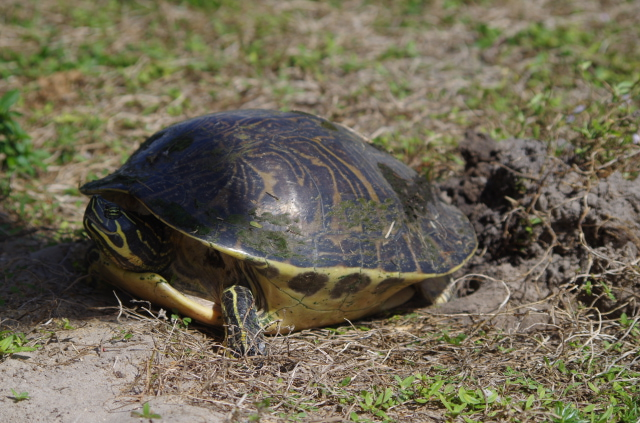 Peninsula Cooter laying eggs
QuestionPeninsula Cooter
QUESTION: I have just w
Peninsula Cooter laying eggs
QuestionPeninsula Cooter
QUESTION: I have just w
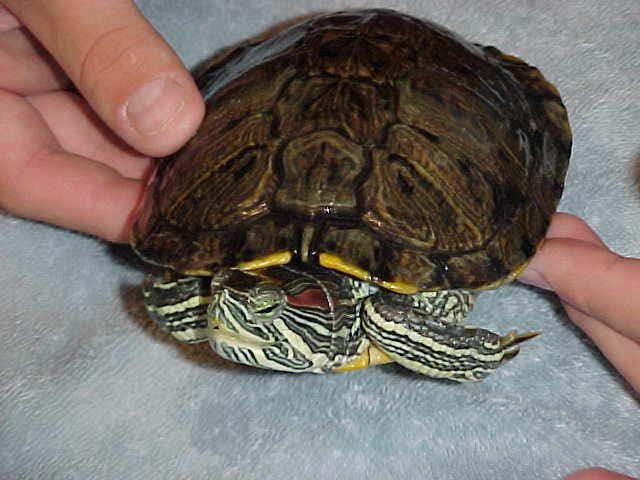 Species ID
Question
Red eared turtle Red eared Turtle
Species ID
Question
Red eared turtle Red eared Turtle
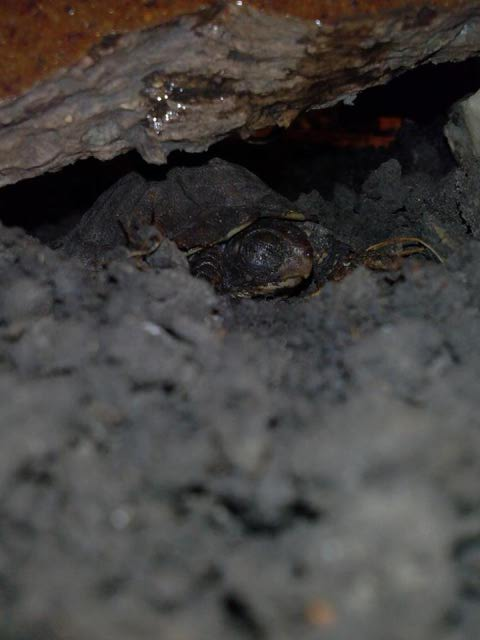 Box Turtle Care
QuestionTorkoal
QUESTION: I have two baby box tu
Box Turtle Care
QuestionTorkoal
QUESTION: I have two baby box tu
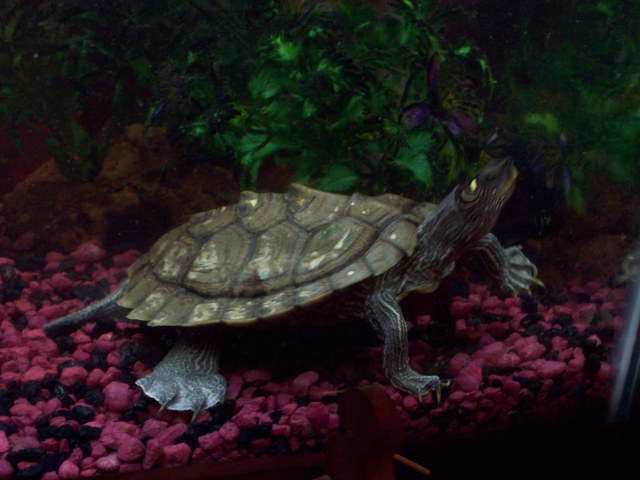 Trying to figure out what Species my
QuestionQUESTION: Trying to figure out what Species my
Trying to figure out what Species my
QuestionQUESTION: Trying to figure out what Species my
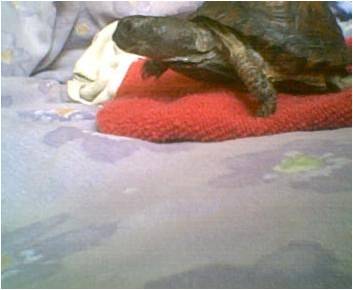 type of box turtle
QuestionQUESTION: i know she is a box turtle but i thou
type of box turtle
QuestionQUESTION: i know she is a box turtle but i thou